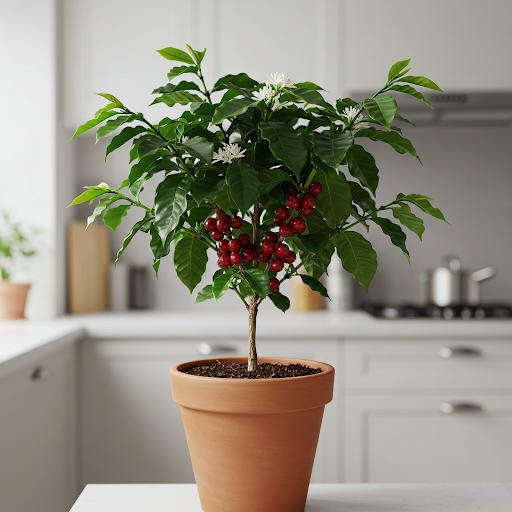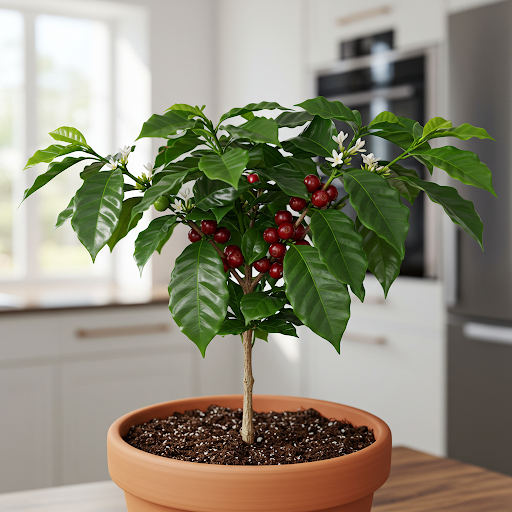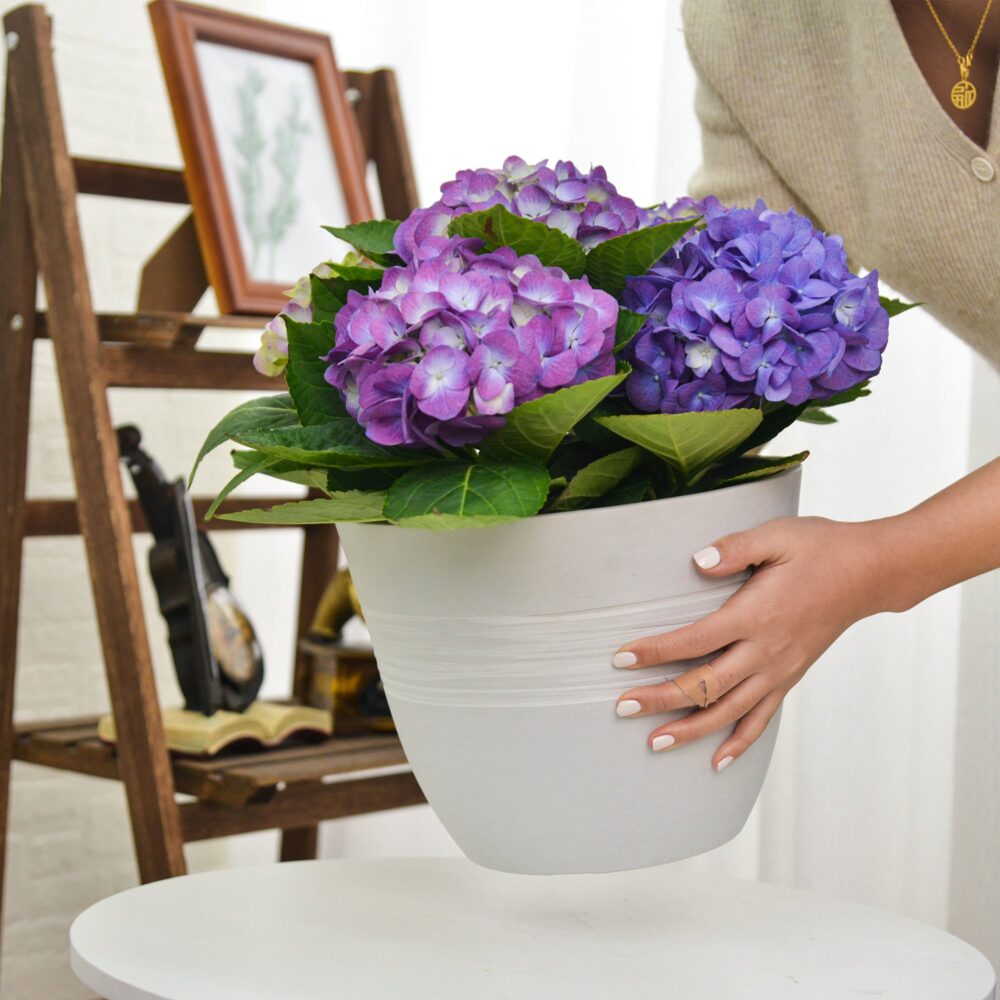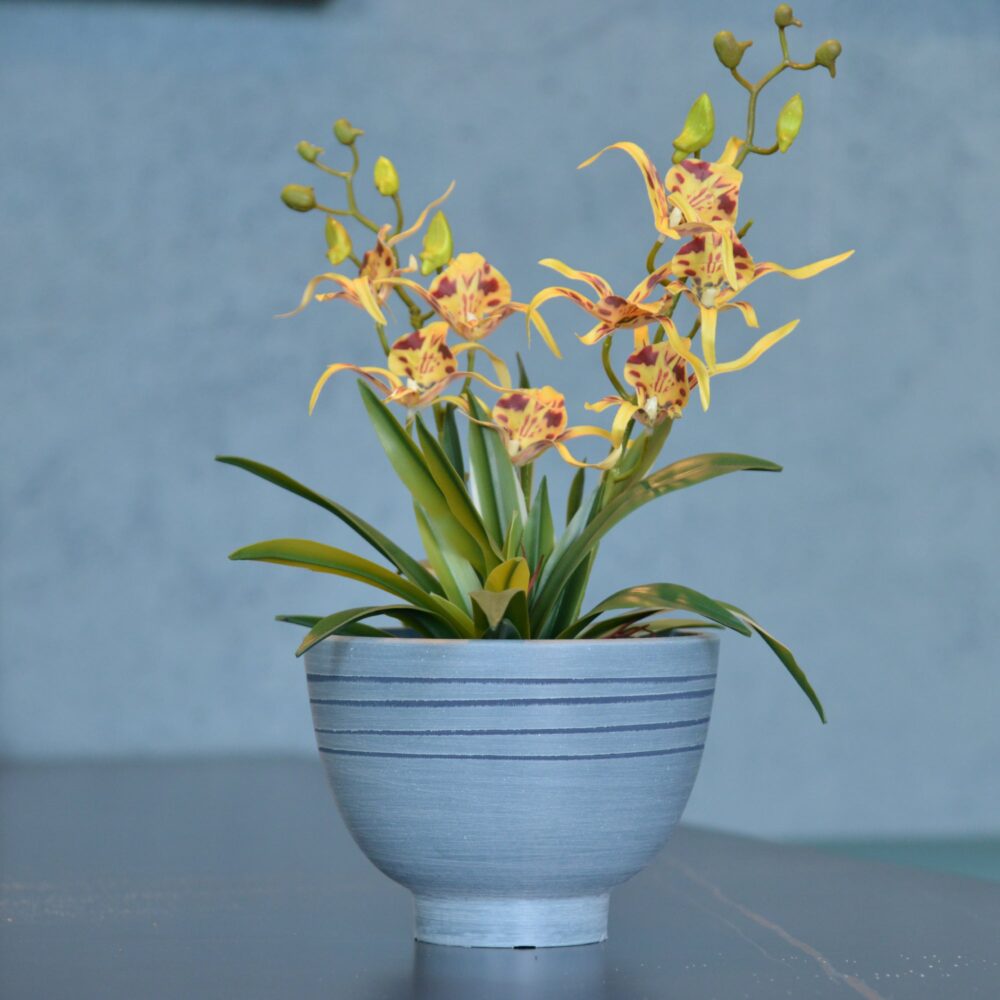Coffee Plant Indoors: The Ultimate Guide to Growing Coffea Arabica at Home
Dreaming of growing your own coffee beans right in your living room? Coffee Plant, scientifically known as Coffea arabica, is a beautiful and rewarding evergreen shrub prized for its glossy green leaves, fragrant white flowers, and of course, its coffee beans. These attractive and relatively easy-to-grow plants, native to the highlands of Ethiopia, are perfect for adding a touch of tropical elegance and the satisfaction of home-grown coffee to your indoor spaces. This comprehensive guide will provide you with everything you need to know to grow Coffea arabica indoors, from selecting the right plant and pot to mastering essential care techniques for a thriving and productive Coffee Plant in your home.

Coffee Plant
What is Coffee Plant (Coffea arabica)?
Coffea arabica, commonly known as Coffee Plant, Arabica Coffee, or Mountain Coffee, is the most widely cultivated species of coffee in the world, prized for its high-quality beans and milder, more aromatic flavor compared to other coffee species. Coffea arabica is an evergreen shrub or small tree characterized by its glossy, dark green, oval leaveswith wavy margins. It produces clusters of fragrant, jasmine-like white flowers, which eventually give way to berries that ripen to red or yellow, each containing two coffee beans. Indoors, Coffee Plants are typically grown for their attractive foliage and ornamental value, and while they can produce flowers and fruit indoors, bean production may be limited compared to outdoor cultivation in ideal climates. Coffee Plants are known for their attractive foliage, fragrant flowers, and the novelty of growing your own coffee, making them a unique and rewarding houseplant.
Can Coffee Plants (Coffea arabica) Thrive Indoors?
Yes, Coffee Plants (Coffea arabica) can thrive indoors and are increasingly popular as houseplants. While they are native to tropical highlands with specific climate conditions, they are adaptable to indoor environments with proper care. Growing Coffee Plants indoors allows you to enjoy their attractive foliage, fragrant blooms, and the unique experience of nurturing a plant that produces one of the world’s most beloved beverages. While indoor-grown coffee plants may produce a smaller yield of beans than those grown in ideal outdoor conditions, they can still be rewarding to grow and may produce enough beans for a small, truly home-grown batch of coffee.
Ideal Indoor Growing Conditions for Coffee Plants (Coffea arabica):
- Varieties of Coffee Plant (Coffea arabica): While Coffea arabica is the main species, there are some cultivars and varieties that are often recommended for indoor growing due to their compact size or other desirable traits. Popular indoor Coffee Plant varieties include:
- *Coffea arabica ‘Nana’: A dwarf variety, naturally smaller and more compact, ideal for indoor pots.
- *Coffea arabica ‘Compacta’: Another smaller, bushier variety well-suited for containers.
- *Coffea arabica ‘Var. Typica’: The original and most common Arabica variety, can be grown indoors but may become larger over time.
- *Coffea arabica ‘Mokka’ (or ‘Mocha’): Known for small, flavorful beans, can be grown indoors.
- Light: Coffee Plants prefer bright, indirect light. In their native rainforest understory, they grow under dappled sunlight. Indoors, they thrive in locations that receive bright, filtered sunlight or bright indirect light for most of the day. East-facing windows are often ideal, providing gentle morning sun. South or west-facing windows can work if the light is diffused with sheer curtains or if the plant is placed slightly away from the window to avoid intense afternoon sun. Insufficient light can lead to weak growth, fewer flowers, and reduced fruiting. Avoid direct, intense sunlight, which can scorch the leaves.
- Soil: Coffee Plants need well-draining, slightly acidic soil that is rich in organic matter. Use a potting mix formulated for acid-loving plants like azaleas, rhododendrons, or camellias, or create your own mix using a base of peat moss or coco coir, perlite or vermiculite for drainage, and compost or well-rotted manure for organic matter. The ideal pH range is between 6.0 and 6.5.
- Watering: Coffee Plants prefer consistently moist soil, but not waterlogged. Water when the top inch of soil is just beginning to dry out. Water thoroughly until water drains out of the drainage holes. Allow the soil to slightly dry out between waterings, but do not let it dry out completely, especially during the growing season. Coffee Plants are sensitive to both overwatering and underwatering. Overwatering can lead to root rot, while underwatering can cause leaf drop and stress. Watering frequency will vary depending on light levels, temperature, humidity, and pot size. Check soil moisture regularly. Use room temperature, filtered water or rainwater if possible, as they can be sensitive to hard tap water.
- Temperature: Average room temperatures between 65°F to 75°F (18°C to 24°C) are ideal during the growing season (spring and summer). In winter, they can tolerate slightly cooler temperatures, down to around 60°F (15°C)at night. Avoid exposing them to temperatures below 55°F (13°C) or sudden temperature fluctuations and cold drafts. They prefer moderate warmth and consistent temperatures.
- Humidity: Coffee Plants thrive in moderate to high humidity, ideally between 50% to 70% or higher. They are native to rainforest environments and appreciate humid conditions. Dry air can lead to brown leaf tips and edges. Increase humidity by:
- Misting Regularly: Mist the foliage frequently with room temperature water, especially in drier indoor environments or during winter heating.
- Pebble Trays: Place pots on trays filled with pebbles and water (water level below the pot base).
- Humidifier: Use a room humidifier, especially during dry seasons or winter heating.
- Grouping Plants: Grouping Coffee Plants with other humidity-loving plants can create a more humid microclimate.
- Bathroom or Kitchen (if suitable light): A well-lit bathroom or kitchen can be suitable locations due to naturally higher humidity.
Planting Your Coffee Plant (Coffea arabica) Indoors:
- Starting from Seed, Seedlings, or Potted Plants: Coffee Plants can be started from seed, but it is a slow process and germination can be uneven. The easiest way to start growing Coffee Plants indoors is to purchase established potted plants or seedlings from nurseries, garden centers, or online retailers specializing in tropical plants.
- Propagation from Cuttings: Coffee Plants can also be propagated from stem cuttings, though it can be moderately challenging. Take semi-hardwood stem cuttings (several inches long) and root them in moist potting mix or water.
- Planting Time: Coffee Plants can be planted or repotted at any time of year indoors, but spring or early summer, at the start of the growing season, is generally recommended for optimal establishment and growth.
Choosing the Right Pots for Indoor Coffee Plants (Coffea arabica):
- Suitable Pot Types: Select pots with good drainage. Terracotta pots, ceramic pots, or plastic pots are all suitable. Terracotta pots are often favored as they are porous and help the soil dry out slightly, which is beneficial for Coffee Plants and helps prevent overwatering.
- Drainage: Drainage is essential for Coffee Plants to prevent root rot. Ensure your chosen pot has drainage holesat the bottom. You can also add a layer of gravel or pot shards at the base of the pot to improve drainage.
- Pot Size: Choose a pot that is appropriately sized for the current size of the plant and allows for some growth. Coffee Plants can eventually become small trees if allowed, but are typically kept smaller in pots indoors. Start with a pot that is 1-2 inches larger in diameter than the root ball when repotting. Young plants can start in 6-8 inch pots. Mature indoor Coffee Plants may eventually need pots that are 10-14 inches in diameter or larger, depending on desired size and variety.
- Potting Mix: Use a well-draining, slightly acidic potting mix as described earlier (acid-loving plant mix, or DIY mix with peat moss, perlite, and compost).
Essential Care Tips for a Thriving Indoor Coffee Plant (Coffea arabica):
- Watering Schedule: “Keep Soil Moist, Allow Top Inch to Slightly Dry”. Water when the top inch of soil is just beginning to dry out. Allow the soil to slightly dry between waterings, but avoid letting it dry out completely. Avoid overwatering and soggy soil.
- Light Management: Bright Indirect Light is Best. Provide bright, indirect light. Avoid direct, intense sun.
- Humidity is Important: Maintain moderate to high humidity for optimal foliage health and growth. Misting, pebble trays, or humidifiers are beneficial, especially in dry indoor air.
- Fertilizing: Regular Feeding During Growing Season. Coffee Plants are moderate feeders and benefit from regular fertilization during the growing season (spring and summer) to support their growth, flowering, and potential fruiting. Fertilize every 2-4 weeks during the growing season with a balanced liquid fertilizer (20-20-20 or similar) diluted to half strength, or a fertilizer specifically formulated for acid-loving plants. Follow package instructions carefully. You can also use organic fertilizers like fish emulsion or compost tea. Reduce or stop fertilizing during the fall and winter dormant period.
- Pruning (for Shape and Size Control): Prune Coffee Plants in late winter or early spring to maintain desired shape and size, remove any dead or crossing branches, and encourage bushier growth. Pruning can help keep them more compact for indoor growing.
- Repotting Schedule: Repot Coffee Plants every 1-2 years, or when they become root-bound or the potting mix is depleted. Repot in spring or early summer. Repotting into fresh potting mix is beneficial for their continued health and growth.
- Flowering and Fruiting (Indoors): Indoor Coffee Plants may take several years to mature enough to flower and fruit, typically around 3-5 years or older. Provide optimal growing conditions (light, humidity, temperature, fertilization) to encourage flowering. Hand-pollination with a small brush may be needed to ensure fruit set indoors. Be patient, as indoor fruiting may be sporadic or limited.
- Pest and Disease Control: Monitor Coffee Plants for pests like aphids, spider mites, mealybugs, and scale insects. Coffee Plants can be susceptible to fungal diseases if humidity is too high and air circulation is poor. Ensure good air circulation and avoid overcrowding. Root rot can occur if overwatered. Ensure proper drainage and avoid overwatering to prevent root rot and fungal issues. Treat any pest infestations promptly with insecticidal soap or neem oil. For fungal issues, improve air circulation and use a fungicide if necessary.
Popular Coffee Plant Forms (within Coffea arabica):
- *Coffea arabica ‘Typica’ (Standard Arabica Coffee)
- *Coffea arabica ‘Nana’ (Dwarf Coffee Plant)
- *Coffea arabica ‘Compacta’ (Bushy Coffee Plant)
- Coffea arabica ‘Mokka’ (Mocha) (Small Bean Coffee)

Coffee Plant
In Summary:
Growing Coffee Plants (Coffea arabica) indoors is a rewarding way to bring tropical beauty, fragrant blooms, and the unique experience of potentially harvesting your own coffee beans to your home. Their glossy foliage and relatively easy care (when their specific needs are met) make them captivating and long-lasting houseplants. By providing bright, indirect light, well-draining, acidic potting mix in pots with drainage, watering to keep soil consistently moist, maintaining moderate to high humidity, and providing regular fertilization during the growing season, you can easily cultivate thriving and beautiful Coffee Plants indoors and enjoy their unique charm and potential for home-grown coffee.
For more detailed botanical information and to explore the cultivation and history of Coffea arabica, you can visit the Wikipedia page on Coffea arabica.
Important Note: Coffee Plants (Coffea arabica) are considered mildly toxic if ingested due to caffeine content in leaves, beans, and other parts. Keep them out of reach of children and pets who may be tempted to chew on leaves or berries. The primary care challenges with Coffee Plants are providing consistent moisture, humidity, bright indirect light, and slightly acidic soil. With attention to these needs, you can successfully grow these fascinating plants indoors.
Planter for Indoor Outdoor Plants, Set of 2 Modern Decorative Plant Pots with Drainage Hole, Decorative Flower Pots
By greenship-seo|2025-01-14T12:26:44+00:00January 14, 2025|Categories: Hand-carving Series|Tags: Decorative Flower Pots|
KC2-21G
By greenship|2024-08-13T06:19:08+00:00August 13, 2024|Categories: Hand-carving Series|
Modern Plant Pots丨Planter for Indoor Plants,8 inch or 10 inch Plant Pots with Drainage Hole,Decorative Flower Pots
By greenship-seo|2025-04-10T08:32:55+00:00January 7, 2025|Categories: Hand-carving Series|Tags: Decorative Flower Pots, Self-Watering Pots|
20VD
By greenship|2024-08-13T06:43:41+00:00August 13, 2024|Categories: Hand-carving Series|
k2-21G
By greenship|2024-08-13T06:17:26+00:00August 13, 2024|Categories: Hand-carving Series|
8 inch/10 inch Planter Indoor Plants, 2 Pack Modern Decorative Plant Pots with Drainage Hole, Cute Bowl Shape Flower Pots
By greenship-seo|2025-04-10T08:03:42+00:00January 9, 2025|Categories: Hand-carving Series|Tags: Decorative Flower Pots, Self-Watering Pots|






